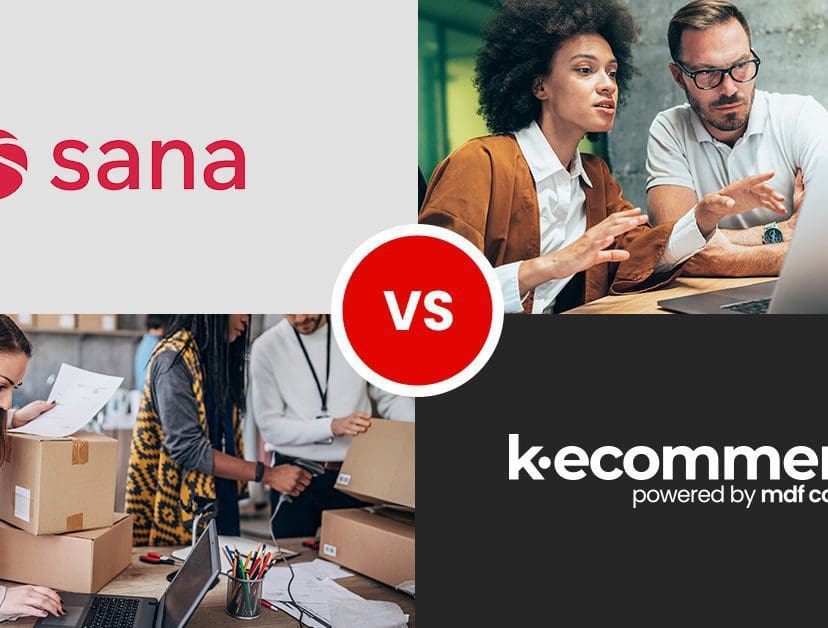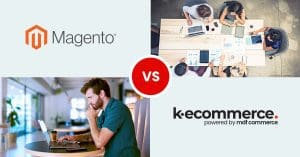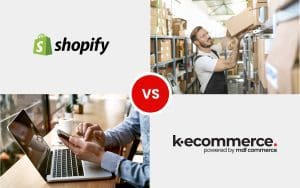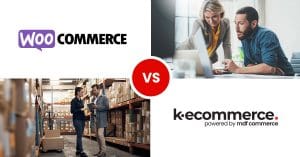
Sana Commerce vs. k-ecommerce: A Quick Ecommerce Platform Comparison

Marketing Team
k-ecommerce
The current market has many B2B ecommerce solutions, all claiming to be the best. And while there’s no doubt that each platform is an option for someone, two ecommerce software solutions stand out: k-ecommerce and Sana Commerce.
Both focus on a fully ERP-integrated approach to ecommerce, differentiating them from open-source platforms like WooCommerce and Magento.
Both k-ecommerce and Sana Commerce ERP integration have the same goal:
- Create a single source of truth for all your data
- Streamline order processes and eliminate unnecessary complexities
- Automate most procedures
- Help you save time, eliminate order errors, and grow your business
That said, when you look closely, you’ll notice some unique differences between the platforms. To help you decide between Sana Commerce vs. k-ecommerce, we’ll walk you through three crucial differences.
Here’s what we’ll cover:
Differences Between k-ecommerce vs. Sana Commerce
- ERP Integration
- Security
- Cost and Services
- Final Thoughts: Sana Commerce vs. k-ecommerce | Which Platform Is the Best?
Differences Between k-ecommerce vs. Sana Commerce
Both k-ecommerce and Sana Commerce focus on distributors, wholesalers, and manufacturers that run their B2B businesses using SAP ERP systems or Microsoft Dynamics.
The two platforms use the client’s ERP to eliminate system siloes, power their ecommerce customer experiences, and minimize data maintenance.
However, even though they both focus on the same industry, the way they integrate into the ERP and do business is entirely different.
Let’s dive into the main differences between Sana Commerce and k-ecommerce:
1. ERP Integration
k-ecommerce and Sana Commerce’s approach to ERP integration differs a lot. Sana Commerce is tightly coupled while k-ecommerce synchronizes to the ERP.
Sana Commerce’s tight integration means that the cloud-based ecommerce platform is built into the ERP, so the webstore and ERP system depend on each other.
Tight ecommerce ERP integration might seem like a good idea, but it can become expensive and troublesome.
Here are the pros and cons of such a solution:
Pros:
- It retrieves data from your ERP system in real-time.
Cons:
- A tightly integrated solution isn’t flexible. It can be challenging to make future changes to your ERP or ecommerce platform. A tech support battle may also occur between the ERP and ecommerce teams to pinpoint the source of a technical issue.
- The webstore and ERP depend on each other. As a result, changing one requires you to change the other, which can be troublesome and expensive.
- Maintenance on your webstore will halt your ERP operations and vice versa, causing additional inconvenience and making the ERP environment unusable.
- ERPs are supposed to handle only a few users. But in a tightly integrated system, the ERP handles all the web traffic. So, a surge in traffic could impact the ecommerce website’s performance.
k-ecommerce uses Sync Technology to synchronize data from your k-ecommerce platform to your ERP’s back-end system and vice versa. It provides an online webshop integrated with your ERP.
Here are the pros of sync technology:
- Since your service-level agreement (SLA) doesn’t depend on the ERP, you don’t have to worry about price hikes or changes in contract terms.
- ERPs are only supposed to handle a few users. That’s why sync technology works best since your ERP and webstore are separated. If there’s a peak of traffic on the website, it won’t affect your ERP.
- Even if the ERP platform is unavailable due to an upgrade or maintenance, your ecommerce website will continue to work.
- Your ecommerce platform will continuously evolve and improve without any impact on your ERP.
- You can add more functionalities to your products later, as the k-ecommerce platform doesn’t modify the ERP.
2. Security
Sana Commerce cloud uses tightly-coupled technology. That means a security breach in the ecommerce solution could reveal any ERP data that should never be made public.
As mentioned, k-ecommerce uses Sync Technology. Since your webstore and ERP system are two different environments, if a security breach were to occur, the information in your ERP wouldn’t be accessible.
Sync Technology uses TLS 1.2 web services to transfer ERP data to your webstore. That ensures your organization’s back-end data is secure and encrypted.
In addition, k-ecommerce services are designed so that, as an online merchant, you don’t store credit card information in your system. When customers enter cardholder data (CHD) into the k-ecommerce credit card popup, the information redirects to our specialized PCI servers and bypasses your system entirely. k-ecommerce also complies fully with PCI-DSS specifications, using industry best practices to protect credit card information and achieve a high level of security in its PCI Environment.
3. Cost and Services
The Sana Commerce vs. k-ecommerce battle also comes down to the platforms’ costs and services. Let’s take a look at each one:
Sana Commerce
- Your SLA depends on the ERP. As a result, you have little flexibility in negotiating a better deal.
- Since the ERP and webshop depend on each other, a change in one requires a change in both. That can be expensive and troublesome.
- Customization is challenging and expensive.
- One platform’s maintenance or upgrade will halt the other, leading to further inconvenience and potentially making the ERP environment unusable.
k-ecommerce
- The k-ecommerce solution is more advantageous than Sana Commerce because it’s all-inclusive (deployment, hosting, maintenance, upgrade, and support).
- Customization isn’t as pricey and complicated as Sana’s integrated ecommerce solution since k-ecommerce uses sync technology instead of tight integration.
Final Thoughts: Sana Commerce vs. k-ecommerce | Which Platform Is the Best For You?
Both Sana Commerce and k-ecommerce have their advantages and disadvantages. However, if your goal is to roll out a solution that meets the following criteria, k-ecommerce is the best choice:
- Turnkey solution: k-ecommerce is designed for SMBs with industry standards and best practices in mind. Our ecommerce solution takes care of everything — from hosting and Content Management Systems (CMS) to payment security and proprietary sync technology — to get you up and running in a matter of weeks.
- Scalable solution: Our ERP ecommerce integration system adjusts and grows with your business, saving you a great deal of work in the long run.
- No surprising fees: k-ecommerce offers a pricing plan where you only pay more as your ecommerce business succeeds and grows. Our ecommerce solution also lets you test, do maintenance, and upgrade for free. We also offer full customer service support.
- Synchronized to your ERP: k-ecommerce natively integrates with Acumatica, SAP Business One ERPs and Microsoft Dynamics ERPs. The platform leverages your existing ERP, empowering you to tailor the ecommerce solution to your specific business needs. It also synchronizes data from your Acumatica or SAP Business One or Microsoft Dynamics back-end system to your webstore and vice versa, saving you money, time, and resources, along with reducing the possibility of human errors.
k-ecommerce can help you get your ecommerce ERP up and running. Contact us today.






